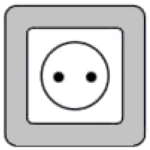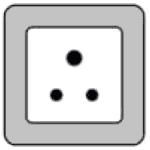Normal 0 false false false EN-US X-NONE X-NONE /* Style Definitions */ table.MsoNormalTable {mso-style-name:"Table Normal"; mso-tstyle-rowband-size:0; mso-tstyle-colband-size:0; mso-style-noshow:yes; mso-style-priority:99; mso-style-parent:""; mso-padding-alt:0in 5.4pt 0in 5.4pt; mso-para-margin:0in; line-height:115%; mso-pagination:widow-orphan; font-size:11.0pt; font-family:"Arial",sans-serif; mso-ansi-language:EN;}
Plug For Nepal: What You Need To Know
What is the plug for Nepal? Before you travel, check the information below to make sure your electronic devices are compatible with the outlet type and voltage.
Electrical Summary
Nepal uses outlet types C, D, M at a voltage of 230V and a frequency of 50 Hz.
Plug Compatibility: Type C, Type D, Type M
Voltage: 230V
Frequency: 50 Hz
Type C

Type D

Type M

Can North Americans use Electronics in Nepal without an Adapter?
No! North Americans will need an adapter for the outlets and a transformer for the voltage when traveling to Nepal. North Americans device plugs will not work with the outlet types in Nepal. Also, the voltage in Nepal is different from North American voltages.
Can Europeans use Electronics in Nepal without an adapter?
Yes! Most Europeans do not need a travel adapter or transformer when traveling to Nepal. Most device plugs will work with the outlet types in Nepal. Also, the voltage in Nepal is the same as in Europe.
What Outlet does Nepal Use?
Type C

Type D

Type C plug sockets have two round pins and no grounding pin. These plugs are typically used with devices that have a voltage of 230V.
Type D plug sockets have three round pins and a grounding pin. These plugs are typically used with devices that have a voltage of 230V.
Type M

Type M plug sockets have three round pins, similar to type D plug sockets. These plugs are typically used with devices that have a voltage of 230V.
Is it safe to drink water in Nepal?
To be on the safe side, you can use common precautions such as boiling tap water for at least one minute, using water purification tablets, or drinking bottled water. It’s also important to note that ice may be made from tap water and that foods may be washed or prepared with tap water.
We recommend always packing a filtered water bottle when traveling:
Travel Essentials
Be sure to check our list of travel essentials before your trip!
Should I get travel insurance when traveling to Nepal?
It is generally recommended to get travel insurance when traveling to a different country. Travel insurance can provide financial protection and peace of mind in case of unexpected events, such as medical emergencies, trip cancellations, lost or stolen baggage, or other travel-related mishaps.
Travel insurance can cover various expenses related to your trip, such as medical expenses, emergency medical transportation, trip cancellation or interruption, lost or stolen baggage or personal belongings, and other travel-related expenses.
Before purchasing travel insurance, it’s important to carefully review the policy details, including the coverage limits, exclusions, and any applicable deductibles or copays. You should also make sure that the policy covers any activities or destinations that you plan to participate in or visit during your trip.
Travel Summary
One of the most popular activities for visitors to Nepal is trekking in the Himalayas, with various routes and difficulty levels available to suit all experience levels. The Annapurna Circuit, Everest Base Camp trek, and Langtang Valley trek are among the most popular routes.
Nepal is also known for its rich cultural heritage, with a variety of historical and religious landmarks to explore, including the UNESCO World Heritage Sites of Kathmandu Durbar Square, Swayambhunath Stupa, and Bhaktapur Durbar Square. Visitors can also learn about Nepalese culture and traditions through music and dance performances, art exhibits, and culinary experiences.
The local cuisine in Nepal is diverse and flavorful, with a mix of Indian, Tibetan, and Chinese influences. Dal bhat, momos, and chow mein are popular dishes, and visitors can also enjoy a variety of street food and tea shops.
Travelers to Nepal should be aware of potential safety risks, such as altitude sickness, natural disasters, and political unrest, and take necessary precautions. It is recommended to obtain necessary vaccinations and ensure adequate travel insurance.
Overall, Nepal offers a unique and rewarding travel experience, with stunning natural beauty, rich cultural heritage, and a range of adventurous opportunities for outdoor enthusiasts.
Traveling to another country? Check out our Countries page for more info.